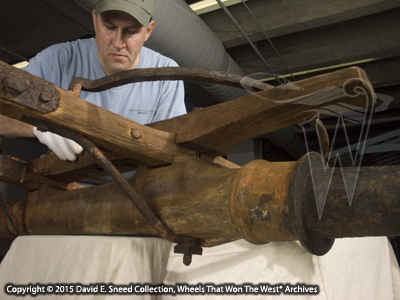It’s always interesting to come face-to-face with an actual wagon orvehicle image from a particular era. Many of these can be linked to the times and places associated withlegendary outlaws, trail drives, emigrant travel, military expeditions, andoverland freighting. So, while it’sthought-provoking to look into the faces of 19th century personalities of theWest, it’s equally fascinating to run head-on into the legendary wheels theysaw, walked past, and rode upon.
Recognizing the traits of 1800’s vehicles has become a passion ofmine. Fortunately, with so many primarysource documents in our western vehicle Archives,the rare files have drawn us closer to what these various transports/brandstruly looked like throughout the different eras of the 19th century. Because of the size of the early vehicleindustry and the competitive similarities between many brands, the reviewprocess can sometimes be extensive. Nonetheless, over time, we’ve been able through point-by-pointexamination to conclusively identify wagon brands in a number of largelyunknown photos. Each time we add anidentity to the list, it helps bring greater insights into who was doing what,where, how, and when.
 |
| In 2007, we were granted exclusive access to this running gear in the Arabia Steamboat museum in Kansas City. From provenance details associated with the ship's cargo to a point by point review, we were able to identify the piece as the oldest surviving Peter Schuttler wagon. It dates to 1856. |
Ultimately, our research almost always leads to some easy conversationstarters. For example... Of thelegendary wagon brands that existed during the timeframe of gold discoveries,outlaw exploits, and cattle drives, what do you suppose the paint, striping,and logos looked like? You can bet itwas much different than what many of the surviving wagons typically show today. Depending on the timeframe, many carried moreflare and extravagance to their designs while also embracing constructiondifferences seldom seen in pieces built in the early 20th century.
Knowing what the different brands were up to at different times notonly helps define history more accurately than what’s typically portrayed inthe movies, it can also be crucial to sound identification efforts andconstruction provenance. In fact, everywagon we acquire goes through this validation process to help corroborate the vehicle’s connection to a particular makerand timeframe. It’s an importantdistinction as the world moves farther away from the horse drawn era. Today, the purity of primary sourceinformation goes beyond well-intentioned guesswork by helping verify thedetails of a vehicle design in its entirety.
When it comes to authentically telling the story of the American West,it’s always a rush to come across a wagon built during or before the time ofBilly the Kid, Geronimo, Jesse James, the Earps, and others. Unlike the distant viewing of an old tintype,finding one of these wheeled dinosaurs is one connection to the West that wecan all experience firsthand. Still,time is running out on the search for survivors. Too many sit unprotected. Unknown to those who pass by and unable tohold on much longer.
Case in point... many years ago, I saw an original wagon with thewell-worn paint and very faded name of “Jackson Wagon.” I have photos today but wish I had bought thepiece. I only saw it for a few minutesand it took me too long to recognize its significance. The wagon could be anywhere now but haslikely finished weathering away or been destroyed. It is the only true Jackson, other thancatalogs and old photos in our collection, that I’ve ever seen. Made by prison labor in Jackson, Michigan,the brand carries a well-documented and legendary reputation in the West.
Like so many others that plied the American frontier, these rareglimpses into yesterday are vanishing. Reminiscent of an aged and weakened image staring out of an old photo, many antiquated wagonsare drifting to a point of no return. So, we search; continually seeking those amazing links to the OldWest. From vehicles to originaldocuments and images, somewhere, the next discovery awaits. It likely will not be obvious in sharing itsidentity. But, just like the incredible discovery of the SteamboatArabia in 1988 (see link in the photo caption above), anything is possible if wedon’t give up.
Please Note: As with each of our blog writings, all imagery and text is copyrighted with All Rights Reserved. The material may not be broadcast, published, rewritten, or redistributed without prior written permission from David E. Sneed, Wheels That Won The West® Archives.